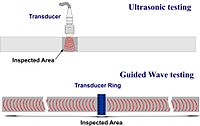
Photo from wikipedia
Composite laminate structures remain an important family of materials used in cutting‐edge industrial areas. Building efficient numerical modeling tools for high‐frequency wave propagation in order to represent ultrasonic testing experiments… Click to show full abstract
Composite laminate structures remain an important family of materials used in cutting‐edge industrial areas. Building efficient numerical modeling tools for high‐frequency wave propagation in order to represent ultrasonic testing experiments of these materials remains a major challenge. In particular, incorporating attenuation phenomena within anisotropic plies, and thin intermediate isotropic layers between the plies often represent significant obstacles for standard numerical approaches. In our work, we address both issues by proposing a systematic study of the fully discrete propagators associated to the Kelvin‐Voigt, Maxwell, and Zener models, and by incorporating effective transmission conditions between plies using the mortar element method. We illustrate the soundness of our approach by proposing intermediate one‐dimensional and two‐dimensional numerical evidence, and we apply it to a more realistic configuration of a curved laminate composite structure in a three‐dimensional setting.
Journal Title: International Journal for Numerical Methods in Engineering
Year Published: 2020
Link to full text (if available)
Share on Social Media: Sign Up to like & get
recommendations!